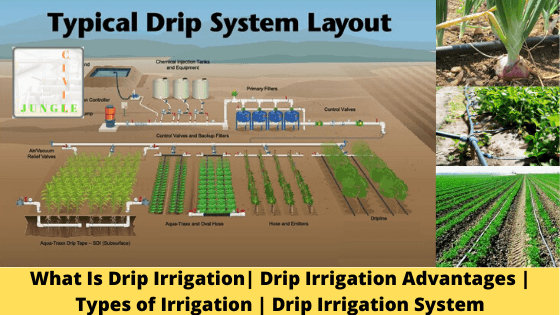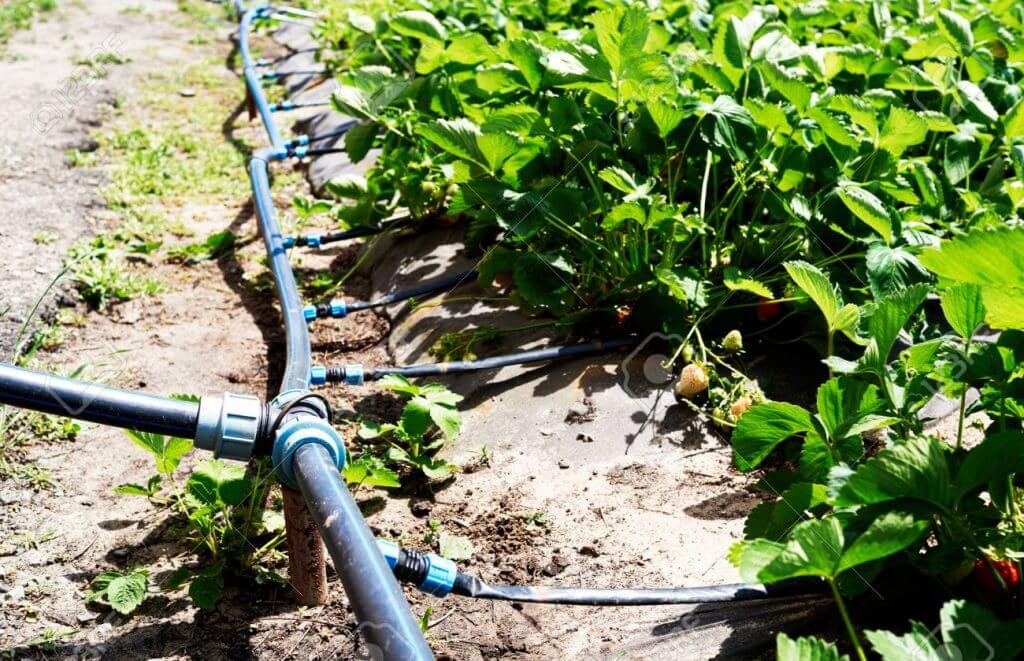What Is Drip Irrigation?
Important Point
Drip irrigation is a type of micro-irrigation system that has the potential to save water and nutrients, allowing water to drip slowly to plant roots, from the ground or below the surface.
The goal is to put water directly into the root area and minimize evaporation. Drip irrigation systems distribute water through a network of pipes, tubes, valves, and emitters.
Depending on how well it is constructed, installed, maintained, and operated. A drip irrigation system can be more efficient than other methods, like surface or sprinkler irrigation.
Also, read: What Is Glass Fiber Reinforced Gypsum | Applications of GFRG | Disadvantages of The GFRG Panel
Types of Irrigation Methods
Here is the list of some irrigation methods and how to use them:
Surface Irrigation
The water is spread evenly across the country with the help of the gravitational pull and does not require a machine to take care of it.
This consists of a large number of irrigation methods in which water is dispersed; the things you need to have before introducing irrigation water into basins are by siphons, closed tubes.
This system is best suited for areas that have a parallel slope or flat surface and a type of soil with moderate fine texture. This helps the surface to spread water evenly as it moves down the basin.
Also, read: 10 Best Cement Companies In India
Sprinkler Irrigation
The water is spread across the country by sprinklers or high-pressure guns from the equator of the earth or from a mobile platform that would be sprayed as it moves.
Manual Irrigation
The water is spread evenly across the field with the help of manual energy, such as jobs and watering cans. This system is very concentrated in manpower.
Each of these methods is useful in a specific way and depends on how you are using it and what you are using. Lade is important because sometimes, the best irrigation system can appear to be flawed.
Be sure to determine the soil you are using and make sure you have a good supply reservoir full of water around you, which would make it easier to care for your plants.
Also, read: What Is Plinth | What Is Plinth Protection | Purpose of Plinth Protection
How does Drip Irrigation Work?
Water and nutrients are delivered across the field in tubes called “drip lines,” featuring smaller units known as “drippers.”
Every dripper emits drops containing water and fertilizers, resulting in the uniform application of water and nutrients directly to the root zone of each plant, across an entire field.
Types of Drip Irrigation System
Drip irrigation works most effectively, depending on how they are designed. There are some variations in drip irrigation.
They need a different installation process, in addition to good maintenance service. Some types of drip irrigation are:
1. Emitter Drip System
The emitter drip system is known to emit small drops of water in the soil. They are good for the bushy landscape. A major problem with this drip system is that the emitters are clogged quickly.
During the winter, the Emitter Drip System is difficult to work with. It is best to avoid this system at that time. The best thing is that the hoses are evenly spaced.
Therefore, your plants receive water evenly. Throughout the garden, you will always be satisfied with the water supply.
Also, read: Hip Roof Vs Gable Roof | What Is Gable Roof | What Is Hip Roof
2. Porous Soaker Hose System
The porous Soaker hose system is used in hedges, rows of shrubs and flower beds. It is very easy to operate. This is made from recycled products, such as car tires.
It has several holes. Porous Soaker Hose has great durability. Your entire body has holes and exudes water. Therefore, the roots are always hydrated, regardless of the climate.
3. Micro Misting Sprinkler
The Micro Misting Sprinkler was built for vineyards and orchards. You can also use it in backyards. This system is capable of providing equal water to all roots.
The false mist helps the shallow roots to remain calm, even on sunny days. That is why the leaves always look fresh, even in gloomy or hot weather. Your plants will never be dehydrated if you use this drip irrigation system.
Also, read: Dog-Legged Staircase | What Is Staircase | Advantages & Disadvantage of Dog-Legged Staircase
4. Watermatic Drip System
Among all drip irrigation systems, the Watermatic drip system is the best. This helps to conserve water when, on the other hand, it minimizes evaporation.
In this system, the micro-spray heads are best used. This is very important for trees and flower beds. You can use this system where there is an insufficient amount of water supply and use of recycled water.
Uses of Drip Irrigation
- You can easily use drip irrigation on farms, commercial greenhouses, residential gardeners. It can also be used where water is scarce.
- Drip irrigation can be effective for crop roots and trees such as coconut and grapes, berries, citrus fruits, strawberries, sugar cane, cotton, corn, and tomatoes.
- For effective use, use the mainline with a return converter, connect a controller to it. A filter can also be used. The filter will ensure that no extra particles enter the tube without water. Connect a pressure regulator to it to be able to control the water supply.
- A good drainage system provides moisture and nutrients to the plants along with the water. Water is the most important ingredient for plants.
- The equal distribution of water facilitates the growth of plants. The drip irrigation system ensures that all your plants obtain water equally. Make sure it is installed properly.
- Don’t forget to use environmentally friendly materials. All of this will give you a good gardening experience.
Also, read: What Is Slump Cone Test | Principle of Slump Test | Types of Concrete Slump
Advantages of Drip Irrigation
Here, the advantages of drip irrigation are as follows.
1. Save water:
Drip irrigation is the system’s ability to water plants efficiently, due to the controlled delivery of water directly to the soil.
Drip irrigation systems consist of tubes through which water travels from the source to the drip emitters (also called micro sprinklers).
The drip irrigation pipe meanders through the landscape beds and soil cover areas, and water literally flows from the emitters to the root areas of the It is really a mouth-watering way.
2. Easy installation:
The drip irrigation installation does not require excavation and rarely disrupts the integrity of a landscape bed during installation.
The piping is woven throughout the area that requires irrigation. Therefore, drip irrigation systems can be moved and are not permanent, like conventional irrigation systems (involving spray heads, pop-up heads, etc.)
3. Water Conservation:
with drip irrigation, water is delivered directly to the soil surface, instead of being sprayed over an area. This direct application of water saves
4. No Drift:
Drip irrigation can deliver 1 to 4 gallons of water per hour to a landscape bed, and there is no drift, which happens when the wind takes dispersed water from the irrigation system to areas that do not need water (its sidewalks), walkways and parking lots). Drift wastes water.
5. Water Bill Savings:
More efficient irrigation in the landscape saves money. Due to an inadequate supply of water, fertilizers, and nutrients cannot reach the roots of all. The drip irrigation system helps to achieve effectively.
- If you want to achieve efficiency in the application of water, it is necessary to install the drip irrigation system.
- Field leveling is done by installing this type of irrigation system. When your field is leveled evenly, you can plant correctly. Whatever the field capacity, they need. The roots must be hydrated.
- Soil erosion and weed growth are reduced. Water distribution can be controlled. According to the need, water is produced for all roots.
- You no longer need a helping hand to water your plants. Therefore, drip irrigation also confirms the zero cost of labor.
- It is a low-cost process that can also be done with low water pressure.
Like this post? Share it with your friends!
Suggested Read –
Originally posted 2022-07-09 17:10:13.






Like!! I blog frequently and I really thank you for your content. The article has truly peaked my interest.
It really helped when you stated that drip irrigation systems are a great way to save water and money from water bills. I would have been more open to the idea of managing a garden because of how expensive it would be to constantly water it enough for it to grow properly. Now that I know that there’s a cheaper and more effective way to do this, I’ll definitely install a drip irrigation system when I start planting seeds for my vegetable garden.
Thanks